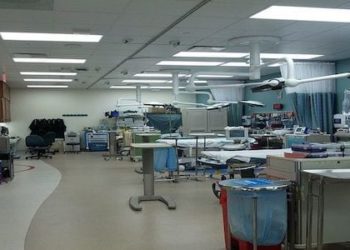Aneurysm diameter useful in determining frequency of surveillance
[tabs tab1=”2MM Rundown” tab2= “2MM Full Report”]
[tab]
Image: CC
1. Abdominal aortic aneurysm (AAA) expansion rate and risk of rupture are directly correlated with aneurysm diameter.
2. A surveillance schedule with conservative imaging frequency can be established for small AAAs, the authors suggest surveillance intervals of 3, 2 and 1 years for AAAs measuring 3.0-3.9 cm, 4.0-4.4 cm, and 4.5-5.4 cm, respectively.
The present study represents the largest meta-analysis to date on the progression and rupture risk for small AAAs. Numerous smaller analyses have been presented in the literature, leading to a wide range of suggested guidelines and inconsistent surveillance practices around the world. By unifying the data from many of these reports, the authors are able to present a well-powered analysis to support their proposed surveillance schedule. Moreover, when compared with the current guidelines put forth by major societies and developed nations, the schedule presented in this paper has the advantage of lowering total number of surveillance scans without appreciably increasing the risks of delayed surgical intervention or rupture.
As this study was a meta-analysis, the findings are limited by the inherent heterogeneity in the composite data set. Indeed, the authors acknowledge wide variation in their results, though they were still able to achieve significance by taking advantage of the large number of patients included. Furthermore, though women were found to be at significantly higher risk of rupture than men, they represented only a small fraction of the aggregate patient population and thus had much smaller statistical influence on the proposed schedule. That said, the present study offers support for a graduated AAA surveillance schedule, and it will hopefully serve as a catalyst for more rigorous development of unified guidelines.
Click to read the study in JAMA
[/tab]
[tab]
Image: CC
1. Abdominal aortic aneurysm (AAA) expansion rate and risk of rupture are directly correlated with aneurysm diameter.
2. A surveillance schedule with conservative imaging frequency can be established for small AAAs, the authors suggest surveillance intervals of 3, 2 and 1 years for AAAs measuring 3.0-3.9 cm, 4.0-4.4 cm, and 4.5-5.4 cm, respectively.
This [meta-analysis]: Data from eighteen randomized and observational studies identified in the literature were combined for a total of 15,471 patients. All included patients had AAA diameters between 3.0 and 5.4 centimeters (all smaller than the 5.5 centimeters, the threshold for surgical intervention). The data was analyzed for multiple factors related to AAA progression, including growth rate, rupture rate, and the timing of thresholds for surgical intervention and increased risk of rupture. The authors found growth rate and rupture rate to be significantly and predictably correlated with aneurysm size. Moreover, they found the risk of growth to the threshold for surgical intervention increased significantly with larger baseline aneurysm diameter, a trend which was even more dramatic with regard to risk of rupture. Based on these findings, the authors suggested surveillance intervals of 3, 2 and 1 years for AAAs measuring 3.0-3.9 cm, 4.0-4.4 cm, and 4.5-5.4 cm, respectively.
In sum: The present study represents the largest meta-analysis to date on the progression and rupture risk for small AAAs. Numerous smaller analyses have been presented in the literature, leading to a wide range of suggested guidelines and inconsistent surveillance practices around the world. By unifying the data from many of these reports, the authors are able to present a well-powered analysis to support their proposed surveillance schedule. Moreover, when compared with the current guidelines put forth by major societies and developed nations, the schedule presented in this paper has the advantage of lowering total number of surveillance scans without appreciably increasing the risks of delayed surgical intervention or rupture.
As this study was a meta-analysis, the findings are limited by the inherent heterogeneity in the composite data set. Indeed, the authors acknowledge wide variation in their results, though they were still able to achieve significance by taking advantage of the large number of patients included. Furthermore, though women were found to be at significantly higher risk of rupture than men, they represented only a small fraction of the aggregate patient population and thus had much smaller statistical influence on the proposed schedule. That said, the present study offers support for a graduated AAA surveillance schedule, and it will hopefully serve as a catalyst for more rigorous development of unified guidelines.
Click to read the study in JAMA
By John Prendergass and Rif Rahman
More from this author: Maternal folic acid supplementation during early pregnancy associated with lower risk of autism, Energy drinks may be harmful to the health of adolescents, Early initiation of antiretroviral therapy linked with lower risk of cognitive impairment in HIV, The virtual lumbar puncture: MRI can predict CSF biomarker levels in patients with neurodegenerative disease
© 2013 2minutemedicine.com. All rights reserved. No works may be reproduced without written consent from 2minutemedicine.com. Disclaimer: We present factual information directly from peer reviewed medical journals. No post should be construed as medical advice and is not intended as such by the authors or by 2minutemedicine.com. PLEASE SEE A HEALTHCARE PROVIDER IN YOUR AREA IF YOU SEEK MEDICAL ADVICE OF ANY SORT. Content is produced in accordance with fair use copyrights solely and strictly for the purpose of teaching, news and criticism. No benefit, monetary or otherwise, is realized by any participants or the owner of this domain
[/tab]
[/tabs]




